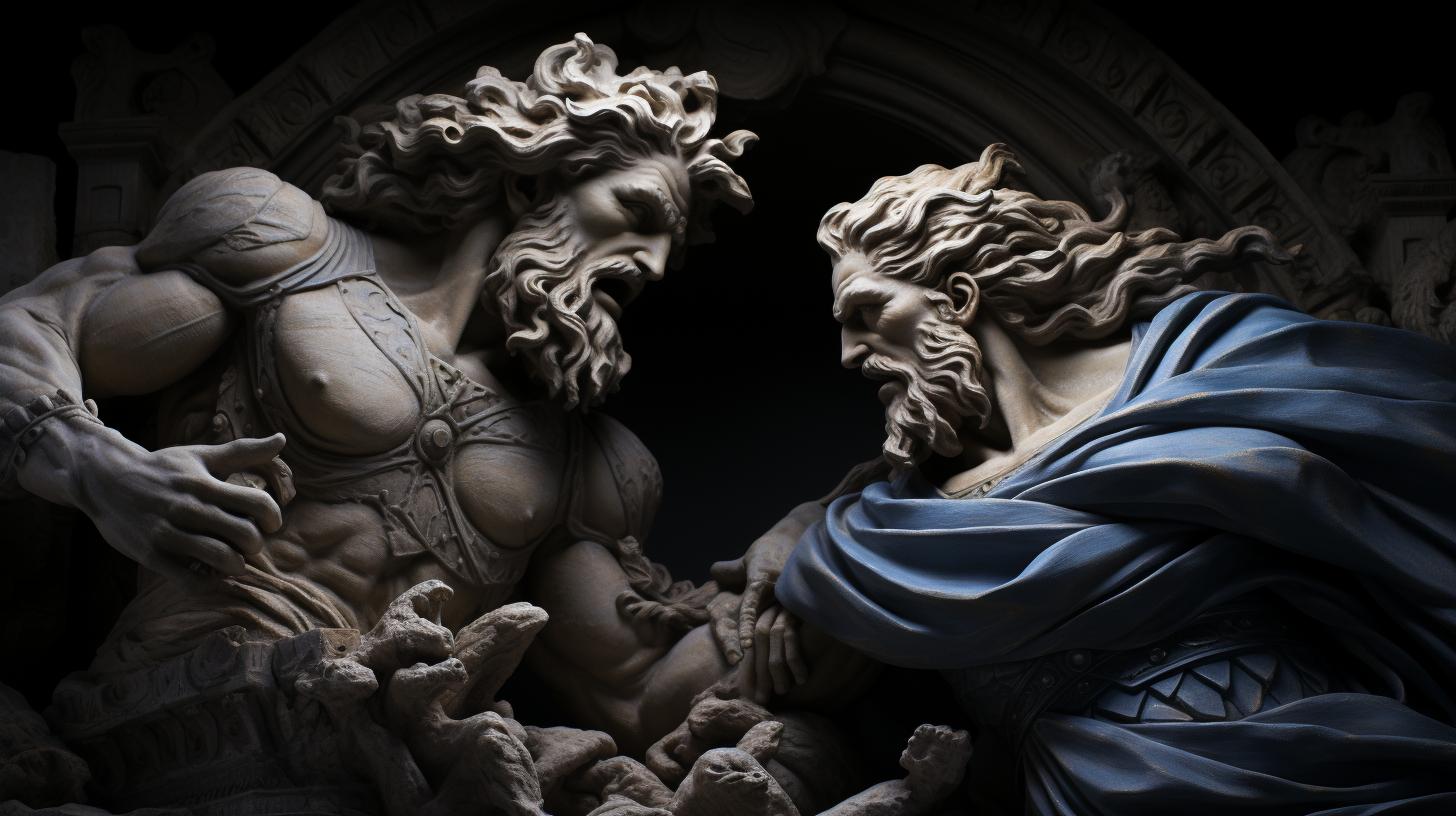Zephyrus: The Greek God of the West Wind Unveiled

Zephyrus, the Greek god of the west wind, holds a prominent place in Greek mythology as one of the Anemoi, the four wind gods. Associated with spring, flowers, and procreation, Zephyrus is known for his rivalry with Apollo and his role in the tragic story of Hyacinthus.
While he had a minor cult in ancient Greece, Zephyrus’ influence can still be traced in Classical Athens and surrounding regions. Depicted as a handsome winged youth, Zephyrus embodies the essence of spring in classical art.
Discover the fascinating tales and symbolism surrounding Zephyrus, the god of the west wind.
Zephyrus in Greek Mythology
Zephyrus, the Greek god of the west wind, holds a prominent place in Greek mythology, embodying the gentle breeze that blows from the west. Let’s delve into the intriguing tales and fascinating aspects surrounding this deity.
Zephyrus: The Greek God of the West Wind
Zephyrus, also known as Zephyros, is the divine personification of the west wind in Greek mythology. Renowned for his gentle and favorable breeze, Zephyrus is closely associated with spring, flowers, and procreation.
This wind deity takes his place among the Anemoi, the four gods of the winds, alongside Boreas, Eurus, and Notus.
The Anemoi: Gods of the Four Winds
In Greek mythology, the Anemoi are the deities responsible for the different winds. Zephyrus, as the god of the west wind, is joined by Boreas (north wind), Eurus (east wind), and Notus (south wind).
Each Anemoi possesses distinct qualities and influences, with Zephyrus reigning as the softest and most favorable wind.
Zephyrus’ Family: Eos, Astraeus, and More
Zephyrus is the offspring of Eos, the goddess of the dawn, and Astraeus, a minor god associated with the stars. Through his lineage, Zephyrus inherits a connection to celestial phenomena and the cycle of day and night.
The family ties of Zephyrus demonstrate the interconnectedness of Greek gods and their domains.
Zephyrus in Ancient Greek Culture and Worship
In ancient Greece, Zephyrus held a lesser-known cult, overshadowed by more prominent deities like the Olympians. However, traces of Zephyrus’ worship can be found in Classical Athens and its surrounding regions.
Zephyrus’ Cult in Ancient Greece
Zephyrus was typically worshipped alongside the other gods of the wind. Although his cult may not have been as widespread or significant as others, devotees recognized Zephyrus as the god of the gentle west wind, associated with favorable breezes and the arrival of spring.
His worshippers may have sought his blessings for prosperous harvests, successful voyages, and the blossoming of flowers.
Zephyrus in Classical Athens and Surrounding Regions
Athens, known for its rich mythology and extensive religious practices, had its share of reverence for Zephyrus. While evidence may be limited, archaeological findings suggest that Zephyrus’ presence was acknowledged through votive offerings and depictions in Athenian art.
It is likely that the Athenians, like other city-states, recognized Zephyrus as an influential deity in the realm of nature and seasons.
- Ancient Athenians appreciated Zephyrus’ role in bringing favorable winds for their seafaring endeavors.
- Zephyrus’ connection to the arrival of spring and the blooming of flowers would have been significant to an agricultural society like Athens.
- Like other gods, Zephyrus may have been invoked during religious festivals and ceremonies to ensure harmony with the natural world.
While the cult of Zephyrus may not have reached the heights of more prominent gods, his presence in Classical Athens and surrounding regions signifies the significance of the west wind and its association with the changing seasons and fertility.
Zephyrus vs Apollo: The Tragic Love of Hyacinthus
Within the realm of Greek mythology, the story of Zephyrus and Apollo’s rivalry over the love of Hyacinthus stands as a tale of both beauty and tragedy.
The Rivalry between Zephyrus and Apollo
The rivalry between Zephyrus, the gentle west wind, and Apollo, the radiant god of the sun, emerged when both fell deeply in love with the handsome mortal youth, Hyacinthus.
Their affections sparked a fierce competition for Hyacinthus’ heart, igniting a rivalry that grew with an intensity only the gods could possess.
The Story of Hyacinthus and Zephyrus’ Involvement
Hyacinthus, renowned for his beauty and grace, found himself torn between the advances of Zephyrus and Apollo. Fate took a tragic twist when, in a fit of jealousy, Zephyrus rashly blew a gust of wind to interfere with Apollo’s throw of a discus during a friendly competition.
Tragically, the ill-fated gust sent the discus off course, striking Hyacinthus and inflicting a fatal blow to the young man’s head. The shock and grief resonated throughout the heavens and beyond, as Apollo sorrowfully mourned the loss of his beloved.
In honor of Hyacinthus, Apollo transformed his lover’s lifeless body into a beautifully fragrant flower known as the hyacinth. Each year, as spring awakens, the hyacinth blooms, serving as a bittersweet reminder of the love shared and lost between Zephyrus, Apollo, and Hyacinthus.
Quick Facts:
- Zephyrus and Apollo’s rivalry stemmed from their love for the mortal youth Hyacinthus.
- Zephyrus played a role in Hyacinthus’ tragic death when his jealous gust of wind deflected Apollo’s discus.
- As a tribute to his fallen lover, Apollo transformed Hyacinthus into the fragrant and vibrant hyacinth flower.
Delve into the depths of mythology to uncover the tales surrounding Zephyrus, Apollo, and their tragic love affair with Hyacinthus.
Zephyrus’ Other Mythological Connections
Zephyrus, the Greek god of the west wind, is not only known for his rivalry with Apollo and his role in the story of Hyacinthus, but he also has various mythological connections with other Greek figures.
These connections shed light on Zephyrus’ diverse significance and associations within Greek mythology.
Zephyrus and Podarge: Parents of Xanthus and Balius
One prominent connection in Zephyrus’ mythological lineage is his relationship with Podarge, a harpy and granddaughter of the sea god Pontus. Zephyrus and Podarge had a divine union and became the parents of the immortal horses Xanthus and Balius.
These magnificent horses played a significant role in Greek mythology, most notably during the Trojan War. Xanthus and Balius were gifted to Peleus, the father of the legendary hero Achilles, and they were revered for their superhuman speed and beauty.
Their lineage traced back to Zephyrus, highlighting the god’s connection to not only the realm of wind but also to the realm of magnificent steeds.
Zephyrus’ Associations with Other Greek Mythological Figures
Boreas: The North Wind
Zephyrus’ association with Boreas, the Greek god of the north wind, further emphasizes the four winds’ interconnectedness in Greek mythology.
While Boreas and Zephyrus were distinct entities, they often appeared together in ancient Greek literature and art, symbolizing the different directional winds that influenced the world.
Eos: The Goddess of Dawn
Zephyrus’ mother, Eos, the goddess of dawn, holds a significant place in Greek mythology.
Eos represents the transition from night to day, and her connection to Zephyrus highlights their shared association with the changing of seasons and natural phenomena.
Notus: The South Wind
As one of the Anemoi, Zephyrus had a close connection with Notus, the Greek god of the south wind.
Together with Boreas and Eurus, Zephyrus and Notus completed the quartet of wind deities, each responsible for specific winds and their respective effects on the world.
Eros: The God of Love
Zephyrus’ association with Eros, the Greek god of love and desire, adds another layer to his complex character.
In some depictions, Zephyrus is seen embracing a young figure, believed to be either Hyacinthus or Eros. This symbolism further ties Zephyrus to the themes of procreation, attraction, and the beauty of nature.
Zephyrus’ mythological connections showcase the intricacies of Greek mythology and the diverse roles and relationships of its deities. From his divine offspring to his associations with other wind gods and significant figures like Eros, Zephyrus’ place in Greek mythology is intertwined with various aspects of the natural and divine world.
Zephyrus in Art and Representation
Throughout history, Zephyrus has been a captivating subject in classical art, inspiring numerous depictions that capture his essence and symbolism. Artists sought to showcase his association with spring, flowers, and the gentle west wind.
Let’s explore two significant aspects related to Zephyrus in art: his depictions in classical artwork and the symbolism behind these representations.
Depictions of Zephyrus in Classical Art
Classical artists often portrayed Zephyrus as a youthful figure, endowed with remarkable beauty and possessing delicate wings that adorned his back. They depicted him with flowing hair, often depicted flying gracefully amidst the meadows, holding a significant presence in numerous paintings and sculptures.
One of the most renowned depictions of Zephyrus is seen in the works of ancient Greek sculptors. These sculptures showcase his elegance and grace, capturing the ethereal nature of the west wind.
Artists paid meticulous attention to details, crafting each curve and contour to convey a sense of movement and dynamism.
In paintings, Zephyrus is often depicted in pastoral scenes, surrounded by vibrant flowers and lush landscapes.
Artists aimed to capture the essence of his domain, using vivid colors and intricate brushstrokes. These artworks evoke a sense of tranquility and harmony, emphasizing the calming influence associated with Zephyrus.
Symbolism and Symbolic Representations of Zephyrus
In addition to his physical depiction, Zephyrus holds significant symbolism in classical art. As the god of the west wind, he represents the gentle and favorable breeze that brings the arrival of spring.
In this context, Zephyrus symbolizes renewal, growth, and the awakening of nature after the dormant winter months.
Zephyrus’ association with flowers further deepens his symbolic meaning. He is often depicted with blossoms, signifying his connection to the natural cycle of life, procreation, and fertility.
The vibrant blooms portrayed alongside him represent the blossoming of nature and the beauty that emerges with the changing seasons.
Moreover, Zephyrus’ wings symbolize his ability to traverse vast distances, carrying the scents and essence of different regions.
This attribute emphasizes his role as a bringer of change, heralding the arrival of new seasons and influencing the cultivation of crops and plant life.
- Zephyrus in Classical Art:
- Youthful and graceful depictions
- Ethereal sculptures capturing movement
- Paintings portraying pastoral scenes and lively landscapes
- Symbolism in Zephyrus’ Representations:
- Representing the arrival of spring and renewal
- Symbolizing growth, procreation, and fertility through flowers
- Wings as symbols of change, traversing vast distances
Zephyrus’ Name and Origins
The Origin and Meaning of the Name Zephyrus
The name Zephyrus, associated with the Greek god of the west wind, has an uncertain origin. It has been linked to the Greek word ζόφος, meaning ‘darkness’ or ‘west,’ and is connected to the proto-Indo-European root *(h₃)yebʰ-, meaning ‘enter, penetrate.’
This suggests a linguistic connection between Zephyrus and the concept of the westward direction.
The Oft-Debated Origins of Zephyrus’ Name
Alternatively, some scholars believe that Zephyrus’ name may have a pre-Greek origin. It is speculated that it could have been used to convey the idea of ‘western’ even before it entered the Greek language.
The exact origins of the name remain a subject of debate among researchers.
- The name Zephyrus is associated with the Greek word ζόφος.
- It is connected to the proto-Indo-European root *(h₃)yebʰ-.
- Some argue that the name may have a pre-Greek origin.
- Its precise meaning and etymology are still a matter of scholarly discussion.
Zephyrus and the Themes of Wind, Seasons, and Nature
Zephyrus and the Winds: Roles and Associations
Zephyrus, as the Greek god of the west wind, plays a significant role in the realm of wind and its associations.
Among the four Anemoi, Zephyrus holds the distinction of being the gentlest and most favorable wind. He is often depicted as a benevolent force, bringing mild breezes and favorable conditions. In Greek mythology, Zephyrus is associated with the calming and soothing effects of a gentle wind.
As the personification of the west wind, Zephyrus had specific roles and associations. He was often invoked to bring favorable weather conditions for sailing and trade, as his gentle breeze facilitated smooth voyages and calm seas.
Zephyrus’ wind was also seen as a harbinger of spring, carrying the scents and whispers of blooming flowers and awakening nature.
- The gentle touch of Zephyrus’ wind breathed life into the dormant earth, signaling the arrival of spring and heralding the renewal of nature.
- Zephyrus’ wind was also believed to have an influence on the procreation of plants and animals, fostering fertility and growth.
- Moreover, Zephyrus’ wind was associated with the western horizon, where the sun sets, symbolizing the transition from day to night and playing a role in the cyclical nature of time.
Zephyrus’ Connection to the Changing Seasons
Zephyrus’ association with the changing seasons is another significant aspect of his mythology.
As the west wind, Zephyrus marks the transition from winter to spring, embracing the arrival of warmth and new life. His gentle zephyrs carry the fragrance of blossoming flowers and awakening flora, signifying the end of barrenness and the beginning of abundance.
In Greek myths, Zephyrus’ wind was seen as the catalyst for the changing seasons, particularly the emergence of spring. The breath of Zephyrus stirs the earth from its slumber and triggers the blooming of flowers, the sprouting of leaves, and the return of vibrant colors.
Zephyrus’ Association with Nature and Natural Phenomena
Zephyrus’ connection with nature extends beyond his role in the seasons. He is closely associated with various natural phenomena, embodying the essence of the gentle breeze that kisses the earth. Zephyrus’ wind carries the whispers of the forest, the rustling of leaves, and the delicate dance of petals in the air.
Zephyrus’ association with nature also encompasses the harmony between wind and water. His mild breezes ruffle the surface of lakes and rivers, creating ripples and waves that add movement and life to the tranquil waters.
Zephyrus’ connection to water symbolizes the unison of elements in the natural world.
- Furthermore, Zephyrus’ wind is known to carry the scents and fragrances of the natural world, enveloping the surroundings with the sweet aromas of blossoming flowers and verdant landscapes.
- Zephyrus’ wind also has a calming effect on nature, gently swaying trees and caressing the meadows, creating a serene atmosphere in which all living creatures thrive.
Overall, Zephyrus’ association with wind, seasons, and nature highlights his role as a beneficent force in Greek mythology.
His presence brings forth favorable conditions, breathes life into nature, and underscores the cyclical nature of the world.
Frequently Asked Questions about Zephyrus
Who were the other Greek gods of the wind?
In Greek mythology, Zephyrus was one of the four gods of the wind known as the Anemoi. The other three were Boreas, Eurus, and Notus. Boreas was the god of the north wind, Eurus was the god of the east wind, and Notus was the god of the south wind.
Zephyrus, the god of the west wind, was unique in his association with gentle and favorable winds.
How was Zephyrus worshipped in ancient Greece?
In ancient Greece, Zephyrus had a minor cult following. While he was overshadowed by more prominent gods like the Twelve Olympians, traces of Zephyrus’ worship can be found in Classical Athens and surrounding regions.
Typically, Zephyrus was worshipped alongside the other gods of the wind, often in association with rituals and celebrations related to favorable breezes, the arrival of spring, and the blooming of flowers.
What were Zephyrus’ other notable myths and stories?
Zephyrus is primarily known for his rivalry with the god Apollo over the love of Hyacinthus. In a fit of jealousy, Zephyrus blew a gust of wind that diverted a discus thrown by Apollo, causing it to strike and kill Hyacinthus.
As a tribute to his beloved, Apollo transformed Hyacinthus into a flower known as the hyacinth. Additionally, Zephyrus is associated with other mythological figures such as Podarge, with whom he fathered the immortal horses Xanthus and Balius, belonging to the hero Achilles.
How is Zephyrus portrayed in modern culture and literature?
Zephyrus continues to be referenced and depicted in various forms of modern culture and literature. His role as the god of the west wind and his association with gentle breezes and the coming of spring have made him a symbol of renewal, growth, and vitality.
Artists and writers often draw inspiration from Zephyrus’ graceful and favoring nature to represent the beauty and positivity associated with the wind and natural elements. Zephyrus’ story and symbolism also find their way into contemporary works, exploring themes of love, jealousy, and the power of nature.
.




















